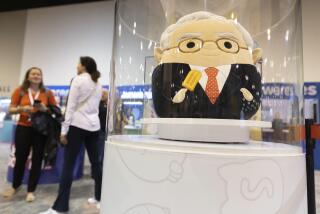Buttoning Up Teddys, Along With Profits
- Share via
OVERLAND PARK, Kan. — Customers smile as they approach the Build-A-Bear Workshop in Oak Park Mall. A short while later, custom-made stuffed animal in hand, they walk out grinning.
But the happiest person on the cheerful premises is Maxine Clark, the retailing whiz who dreamed up the store “Where Best Friends Are Made.”
Everywhere she turns, Clark sees customers selecting fake-fur skins from bins, getting them stuffed and stitched up, then dressing them for the trip home in their own “condos.”
Clark opened the first Build-A-Bear Workshop in St. Louis in October 1997, a year after resigning as president of the $2.3-billion Payless ShoeSource Inc.
This year, with 11 stores open at premier malls from Maryland to Arizona and three more about to open, she expects sales to top $18 million.
It takes a lot of $10 stuffed teddies, bunnies, pandas and cows to produce that kind of revenue. And perhaps it takes a child to explain the appeal of a bear you made yourself.
“A bear from here is special,” says 10-year-old Sarah Hagan of nearby DeSoto, who has made three bears and a panda on earlier visits. “It comes from the heart instead of having it bought from some store.”
Plus, adds Sarah’s mother, Alicia Hagan, the cardboard condos are fun to color. Sarah’s younger cousin Wes Clarkson nods agreement without taking his eyes off the practiced hands of an employee machine-stuffing a brown bearskin.
Clark, 50, whose resume also includes executive vice presidencies at the old Venture Stores Inc. and the May Co.’s Famous-Barr stores, is herself passionate about all things teddy-bear. Chief Executive Bear, she calls herself.
But even she is amazed by the growth of the chain she launched with more than $4 million in venture capital. Twenty-five more stores are to open next year, with 300 planned by 2007.
“The biggest surprise to me was how fast people caught on to the concept,” Clark said during her visit to the Overland Park store. “I thought it would take us a couple more years to get to the sales level we’re at today.
“And I’ve been surprised how varied and diverse our customer base is. I thought it would mostly be children 5 to 10 years old, but it’s not. It’s everybody.”
Clark’s timing in launching make-it-yourself stuffed animal shops was dead-on, experts say.
“It’s retail as entertainment,” said industry consultant Chris Byrne, editor of the weekly Toy Report. “We’ve seen in the last few years a real blurring between shopping as a necessity and as a major entertainment pastime.
“Retail has become so homogenized in the United States that anything that provides a unique experience and a one-of-a-kind product is pretty cool.”
Gary Cross, a history professor at Pennsylvania State University, notes a resurgence of the kind of affection for individualized toys seen in the early 1980s, when children “adopted” millions of Cabbage Patch dolls.
“Then came some extraordinarily uniform and mass-produced products like Strawberry Shortcake and the Care Bears, of which children had virtually identical sets,” said Cross, author of “Kids’ Stuff: Toys and the Changing World of American Childhood.”
Throughout it all, the humble teddy bear--about as low-tech as toys get these days--has endured, partly because stuffed bears “have long had the quality of being highly personal,” Cross said. “People identify the teddy bear with uniqueness, a personal relationship.
“I think this store is a very smart idea.”
So does Jan Regan of Fairway, Kan., a Kansas City historian and tour guide who has come into the store on a day off “to pamper myself and build a bear.”
“I give these as presents all the time. People just love them,” says Regan, who has also built six stuffed bunnies that now occupy a park bench in her home.
Regan exchanges hugs with a few of the many employees on duty in the cheerful, brightly decorated shop. “They know me here,” she says.
Clark looks on, reveling in such relationships between her customers and the employees--dubbed “Master Bear Builders”--she chooses for their warmth and good humor.
“It’s teddy bear karma,” Clark says. “Since teddy bears became a more important part of my life, everything good has happened.”
More to Read
Inside the business of entertainment
The Wide Shot brings you news, analysis and insights on everything from streaming wars to production — and what it all means for the future.
You may occasionally receive promotional content from the Los Angeles Times.










